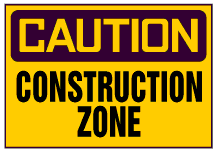 Some
recent ASRS reports show that runway transgressions are often the result
of confusion about taxi instructions at runway/taxiway intersections.
In a report from a corporate aircraft First Officer, time pressure helped
to fuel the misunderstanding:
Some
recent ASRS reports show that runway transgressions are often the result
of confusion about taxi instructions at runway/taxiway intersections.
In a report from a corporate aircraft First Officer, time pressure helped
to fuel the misunderstanding:
- The problem
arose when we became rushed and distracted by our eight-minute time
limit to make our takeoff slot for flow control. The controller instructed
me to cross the runway at Taxiway X, taxi the full length of Runway
07, and hold short. I misunderstood the taxi instructions. I taxied
onto active Runway 07, and proceeded to back-taxi down the runway
to turn around and hold awaiting further takeoff instructions. What
we really should have done was cross Runway 07, taxi on the parallel
taxiway, and hold short at the end of the runway. The controller questioned
my actions, and told us to taxi down and clear the runway immediately.
As we were leaving the runway, I saw an aircraft that I believe the
Tower had sent around.
The instruction to "cross
the runway at Taxiway X" should have been a heads-up to the crew
not to taxi onto the runway. In a callback conversation with an ASRS
analyst, the reporter stated that in the future, the flight crew will
verify any clearance to taxi onto a runway.
Absence of definitive ATC
instructions lured another corporate flight crew into a runway transgression.
The First Officer reports:
- We were
cleared to land Runway 30. No "hold short of Runway 20"
or anything. On rollout, we were not given any taxi-off instructions
because Tower was busy with someone who was having radio problems.
I believed there was some traffic landing behind us, and I thought
we should clear the runway as soon as possible because that's what
you are supposed to do. We taxied clear of Runway 30 by turning onto
Runway 02/20, and stopped awaiting further ATC instructions. The controller
told us in the future not to taxi onto another runway because it messes
up his separation.
In the landing clearance,
the absence of a "hold short" instruction was not permission
for the flight crew to enter Runway 20 and stop there. In this case,
there were intersecting taxiways shortly before and beyond the intersection
with Runway 20 which could have provided appropriate turn-offs. The
Aeronautical Information Manual (AIM) states that pilots should exit
the runway at the first available taxiway or as instructed by ATC. The
AIM Section 4-3-20 offers additional information on exiting the runway
after landing.
 A
report from a Local (Tower) Controller points out the increased runway/taxiway
confusion that can result during airport construction activities.
A
report from a Local (Tower) Controller points out the increased runway/taxiway
confusion that can result during airport construction activities.
- Ground
Control requested to cross a small airplane at the departure end of
Runway 31. I approved it. This is a non-standard operation due to
the main taxiway being closed for construction. The airplane pilot
turned onto the runway instead of crossing it as instructed. He observed
a jet turning onto Runway 31 [for departure]. He moved over to the
edge of the runway, but never said anything. The color of the aircraft
and its position were such that it blended in with the runway paint.
I cleared the jet for takeoff, then observed the airplane just prior
to the jet rotating. After the jet passed over the airplane, the airplane
pilot asked Ground Control if he was in the right place.
In
a subsequent conversation with the controller, the pilot indicated that
he was unaware that there was a parallel taxiway available, and so turned
onto the active runway. When airport construction or any other unusual
activity renders runway and taxiway operations non-standard, both pilots
and controllers need to use extra caution to ensure that taxi instructions
are clearly understood and followed. Pilots can give themselves an edge
by having airport diagrams close at hand to confirm taxi routes.
ELT
Interference

A situation commonly associated
with GA pilots--an ELT false alarm--became a serious distraction to
a commuter flight crew. The First Officer reports:
- From first
contact with Ground Control until landing ...the ELT signal could
be heard strongly on all frequencies. The sound was so loud that it
was hard to hear and understand any ATC transmissions. The Captain
elected to continue the flight. After landing, I climbed into the
rear baggage compartment and found a box jammed into the ELT. After
removing the box and resetting the ELT, the signal stopped. In the
future, I would suggest stopping the aircraft and checking to see
if it was my ELT.
Pilots' quick responses to
an ELT signal can save ATC and the Civil Air Patrol from scrambling
to a false alarm, as well as save other pilots the frustration of trying
to communicate over the sound of a transmitting ELT. The reporter does
not indicate what, if any, repercussions resulted from this noisy flight.
"Helping
Out" ATC
Air Traffic Controllers are
constantly choreographing the ever-changing aerial and ground flow of
traffic. They rely on pilots to provide accurate information and follow
ATC clearances to keep the traffic movement progressing smoothly and
safely. In our first report, the ground flow nearly came to a grinding
halt when a training aircraft "stepped on the toes" of an
air carrier jet. A Ground Controller reports:
- The aircraft,
with a student and instructor on board, had been operating in the
touch-and-go pattern, then made a full stop. The student was instructed
to turn right at Taxiway X and hold short of Taxiway Z for a taxiing
jet. The student read back the instructions, turned onto Taxiway X,
and appeared to slow down. Then he was observed to speed up toward
Taxiway Z, putting him on a collision course with the jet. ATC instructed
the [student] to stop, which he did, but he had already crossed the
hold line. The jet had to move to the side of the taxiway to get by.
[Later] the student stated that he had heard and understood the instructions.
He stated that his instructors had taught him to "help out"
the controllers whenever he felt he could. He was certain he could
"beat out" the jet. The instructor supported the student's
viewpoint.
There are ways to "help out"--with accurate position reports,
etc.--but not following an ATC instruction is not a help.
In another report, marginal
weather and rising terrain in the direction of flight should have encouraged
the pilot to follow the vectors provided by the reporter, a Departure
controller frustrated in his efforts to keep the pilot on course.
- The aircraft
had filed direct to XYZ VORTAC, and on to the southeast at 9,000 feet.
I issued a route direct ABC VORTAC [to the northwest] climbing to
5,000 feet, since as filed would have put the aircraft in Center's
airspace without prior coordination. There is very rapidly rising
terrain and obstructions as you proceed southeast from here, while
to the northwest the terrain is lower. The aircraft took off and was
tracking southeast. He stated that he was going to ABC VORTAC. As
he proceeded southeast, I lost communication with him, and observed
him level at 5,000 feet. By the time I was able to re-establish communication,
he was ten miles southeast of here and he still said he was proceeding
direct to ABC VORTAC. After getting the aircraft identified, I was
able to issue a clearance on course and climb him to 9,000 feet.
The pilot probably figured, "Why go northwest when the controller
will probably put me on course [to the southeast] right away. The
controller only wants to delay me..." Or, there was a complete
loss of situational awareness by the pilot, blindly flying along into
rapidly rising terrain, and trying to figure out why the controller
was repeatedly asking him if he was going northwest.
We issue clearances with very good plans in mind...it is to keep you
out of someone's way, or to avoid an unplanned close encounter with
the earth.
Helping
Other Crew Members
ATC's choreography can also
be disrupted due to flight crew distraction and subsequent loss of intra-cockpit
coordination. A Captain's report provides an example.
- While
we were in level cruise at FL330, Center cleared us to FL290, "pilot's
discretion" to 11,000 feet (or so I thought). I dialed in 11,000
feet in the altitude window, and the First Officer [FO] acknowledged.
The first clue I had that something was amiss was when I noticed another
aircraft...we were approaching FL270, and the FO told me we were only
cleared to FL290.
The First Officer pinpoints
the causes of the confusion:
- During
the conversation with the controller, a conversation was going on
within the cockpit with a deadheading crew member, which may have
contributed to the FO and Captain not verifying the altitude assignment
with each other. The crew had several tasks in progress, with briefing,
receiving ATIS, and making "in range" calls.
Although the company communications
might have been necessary, the timing of the conversation with the jump
seat passenger was inopportune, interfering with the intra-cockpit communication
that might have prevented the altitude deviation.
Another Captain likewise
attributes an altitude deviation to workload and non-ATC communications.
- Shortly
after takeoff, we were cleared to 5,000 feet. I left the frequency
to call company operations, get arrival ATIS, and call arrival airport
operations. While I was off the frequency, we were cleared to go direct
to a VOR when reaching 3,000 feet (but ATC expected us to continue
the climb to 5,000 feet). When I got back on frequency, I asked the
FO about our latest clearance, and he said, "Direct to the VOR,
maintain 3,000 feet."
Contributing factors were: a new Captain (one month) paired with a
new FO (two months); a 20-minute flight [with] high workload; and
the need for the pilot-not-flying to leave the frequency three times
to make required company calls.
Company communications are
important but may need to be re-prioritized so that both crew members
are available to confirm ATC clearances.


 Some
recent ASRS reports show that runway transgressions are often the result
of confusion about taxi instructions at runway/taxiway intersections.
In a report from a corporate aircraft First Officer, time pressure helped
to fuel the misunderstanding:
Some
recent ASRS reports show that runway transgressions are often the result
of confusion about taxi instructions at runway/taxiway intersections.
In a report from a corporate aircraft First Officer, time pressure helped
to fuel the misunderstanding:
 A
report from a Local (Tower) Controller points out the increased runway/taxiway
confusion that can result during airport construction activities.
A
report from a Local (Tower) Controller points out the increased runway/taxiway
confusion that can result during airport construction activities.
